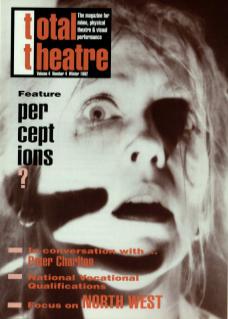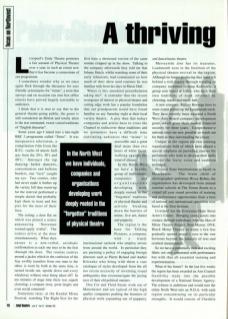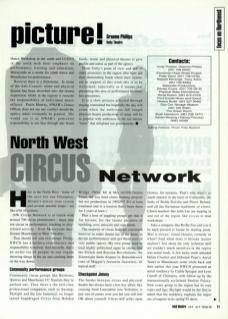Liverpool's Unity Theatre promotes a fair amount of Physical Theatre over a year, to such an extent now that it has become a cornerstone of our programme.
I sometimes wonder why, as we once again flick through the thesaurus for user friendly synonyms for ‘mime’, a term that surveys, and on occasion our own box-office returns, have proved largely resistible to audiences.
I think that it is true to say that to the general theatre-going public, the genre is still considered un-British and totally alien to the text orientated, sweet-voiced traditions of ‘English theeartar’.
Some years ago I tuned into a late-night BBC 2 programme called Turns. It was inexpensive television, a compilation film from the BFI vaults of music hall acts from the 20s, 30s and 40s. Amongst the tap dancing ballet dancers, contortionists and balloon benders, one ‘turn’ caught my eye. Two comics, who had never made it further up the variety bill than warm-up for the interval performed a simple sketch that probably kept them in stout and hot pies for the most of their lives.
The setting: a door flat on which was pinned a notice announcing ‘Storeman wanted-apply within’. The comics arrive at the door simultaneously. What then ensues is a non-verbal, acrobatic confrontation as each one tries to be the first through the door. The routine centres around a jacket which in the confusion of the fray swiftly transfers from one man to the other, is worn by both at the same time, is turned inside out, upside down and every whichway without once being taken off! In ten minutes of stage time there was superb clowning, a compact story, great laughs, and even social comment!
Sometime later, at the Kendal Mime Festival, watching The Right Size for the first time, a shortened version of the same routine cropped up in the show. Talking to the company afterwards they told me that Johnny Hutch, whilst watching some of their early rehearsals, had commented on how much of their show used routines he was familiar with from his days in Music Hall.
Where is this anecdotal perambulation taking me? A reminder that the recent resurgence of interest in physical theatre and cutting edge work has a popular foundation that our grandparents would have found familiar on any Saturday night at their local variety theatre. A pity then that today’s companies and artists have to cross the Channel to rediscover these traditions and we promoters have a difficult time convincing audiences that ‘mime’ is accessible and a great deal more than two hours of white-faced walking against the wind of silence.
In the North West we have a healthy group of individuals, companies and organisations developing work deeply rooted in the ‘forgotten’ traditions of physical theatre and actively breaking down the barriers of mime, live art, dance and puppetry.
The region is the base for Talking Pictures, a company with a truly international outlook who employ artists from around the world. In particular they are pursuing a policy of engaging foreign directors such as Pierre Byland and Andrei Kritenko who bring with them a vast catalogue of styles developed from the all too recent necessity of inventing visual ambiguities that circumnavigate the prying eyes of their old political masters.
Doo-Cot and Third Estate work out of Manchester and are typical of the high quality companies pushing the frontiers of physical work expanding out of puppetry and dance/music theatre.
Merseyside also has its treasures. Loudmouth were in the forefront of the physical theatre revival in the region. Although no longer producing, they have left behind a rich legacy through training or company members joining Kaboodle, a group now based at Unity, who have their own traditions of work informed by clowning, masks and music hall.
A new company, Rejects Revenge have to some extent picked up the Loudmouth torch. They have recently been awarded a North West Arts Board company development grant, which gives them modest financial security for three years. Comprehensive national tours are now possible so watch out for them as they start treading the circuit.
Unique to the region are two training organisations both of which have placed a special emphasis on providing courses for performers who want to develop their skills beyond the fruity voice and audition technique.
Physical State International is based in Manchester. The brain child of choreographer/performer Rivca Ruben, the organisation has developed from annual summer schools at The Green Room to a virtual all-year-round provider of training and performance opportunities from a host of national and international specialists now based at the Zion Institute.
Liverpool has the Everyman Hope Street Actor's Centre. Bringing young actors into contact, through workshops, with the likes of Mime Theatre Project, Bim Mason, DV8, Black Mime Theatre to name a few has gradually opened people's eyes to the vast horizons beyond the sanctity of text and cerebral interpretation.
So we have a potentially rich and exciting fabric not only concerned with performance but with all that essential training and experimentation.
What of the future? In the last few weeks the region has been awarded an Arts Council feasibility study into the possible development of a National Dance Agency. The scheme is ambitious and would turn the entire North West into an N.D.A. with each region concentrating on its particular strengths. It would consist of Cheshire Dance Workshop in the south and LUDUS in the north with their emphasis on performance, training and education: Merseyside as a centre for youth dance and Manchester for performance.
However, there is a dichotomy. In terms of the Arts Council, mime and physical theatre has been absorbed into the drama department whilst in the regions it remains the responsibility of individual dance officers. Paula Murray, NWAB's Dance Officer, does not see any conflict should the agency status eventually be granted. She would see it as NWAB's particular responsibility to see that through arts board funds, mime and physical theatre is given profile and status as part of the agency.
From Unity's point of view and that of other promoters in the region who have put their diminishing funds where their mouths are in support of this work, this is to be welcomed, especially as it means that presenting this area of performance becomes less precarious.
It is a slow process affected through staying committed but hopefully the day will come when the ambitious full-length physical theatre productions of today will be as popular with audiences as the ten-minute ‘turns’ that delighted our grandparents.


